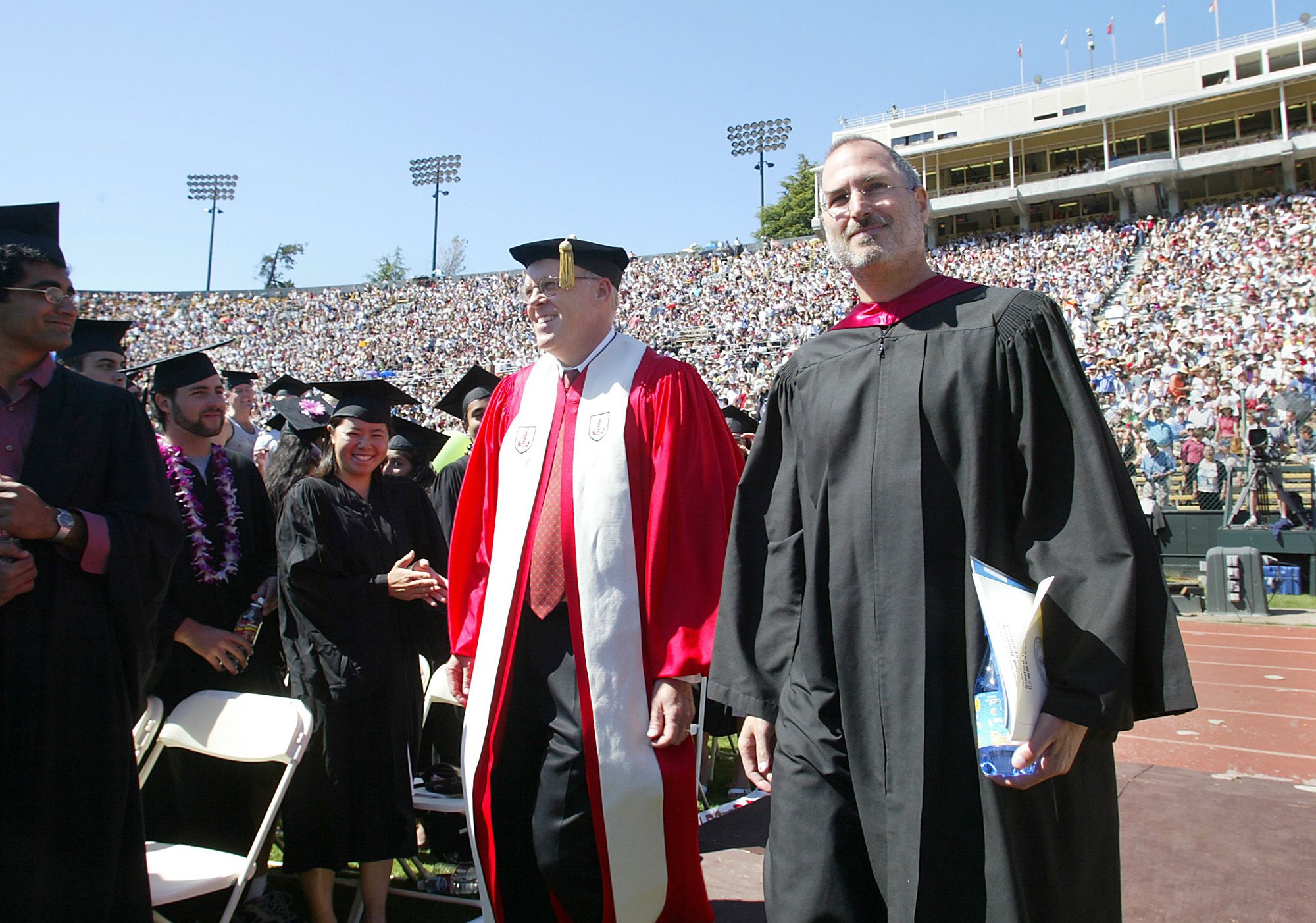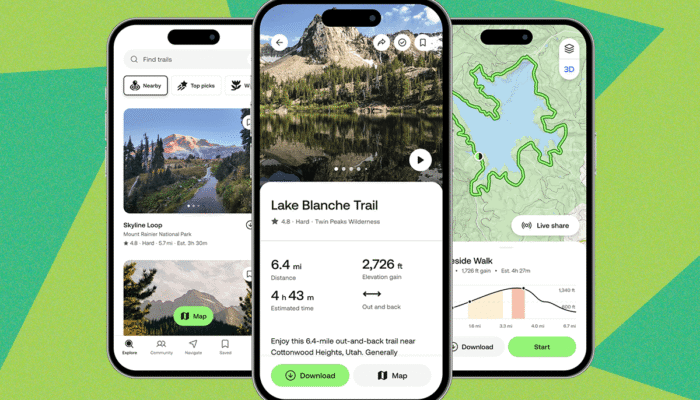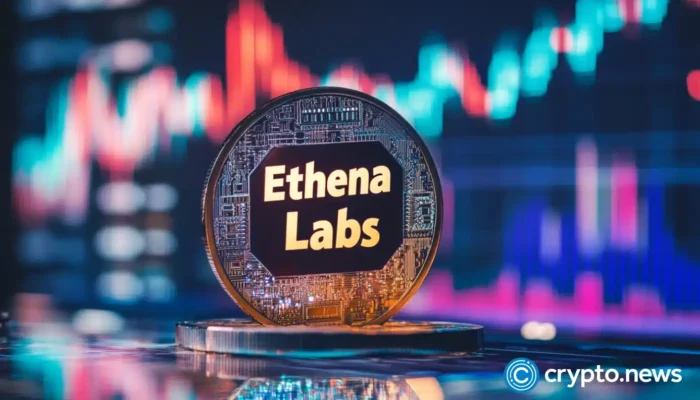In early June 2005, Steve Jobs emailed his friend Michael Hawley a draft of a speech he had agreed to deliver to Stanford University’s graduating class in a few days. “It’s embarrassing,” he wrote. “I’m just not good at this sort of speech. I never do it. I’ll send you something, but please don’t puke.”
The notes that he sent contained the bones of what would become one of the most famous commencement addresses of all time. It has been viewed over 120 million times and is quoted to this day. Probably every person who agrees to give a commencement speech winds up rewatching it, getting inspired, and then sinking into despondency. To mark the 20th anniversary of the event, the Steve Jobs Archive, an organization founded by his widow, Laurene Powell Jobs, is unveiling an online exhibit with a remastered video, interviews with some peripheral witnesses, and ephemera such as his enrollment letter from Reed College and a bingo card for graduates with words from his speech. “Failure,” “biopsy,” and “death” were not on the card, but they were clearly on Jobs’ mind as he composed his remarks. (If you somehow have never viewed this speech, maybe you should watch it in the video player below, then return to this account suitably verklempt.)
Stanford Commencement Bingo card.
Courtesy of Special Collections & University Archives, Stanford University Libraries
Jobs dreaded giving this speech. The Jobs I knew stayed in a strictly policed comfort zone. He thought nothing of walking out of a meeting, even an important one, if something displeased him. His exacting instructions to anyone charged with preparing his meals rivaled those for the manufacture of iPhones. And there were certain subjects that, in 2005, you best never broach: the trauma of his adoption, his firing from Apple in 1985, and the details of his cancer, which he held so closely that some wondered if it was an SEC violation. So it’s all the more astonishing that he set out to tell precisely these stories in front of 23,000 people on a scorching hot Sunday in Stanford’s football stadium. “This was really speaking about things very close to his heart,” says Leslie Berlin, executive director of the archive. “For him to take the speech in that direction, particularly since he was so private, was incredibly meaningful.”
Jobs actually wasn’t the graduating class’s top choice. The four senior copresidents polled the class, and number one on the list was comedian Jon Stewart. The class presidents submitted their choices to a larger committee, including alumni and school administrators. One of the copresidents, Spencer Porter, lobbied hard for Jobs. “Apple Computer was big, and my dad worked for Pixar at the time, so it was the obvious thing that I represent the case for him,” Porter says. Indeed, legend has it that Porter was the inspiration for Luxo Jr., the subject of Pixar’s first short film and later its mascot. When his dad, Tom Porter, brought Spencer to work one day, the story goes, Pixar auteur John Lasseter became entranced by the toddler’s dimensions relative to his father’s and got the idea for a baby lamp. In any case, Stanford’s president, John Hennessy, liked the Jobs option best and made the request.
By this point Jobs had declined many such invitations. But he’d turned 50 and was feeling optimistic about recovering from cancer. Stanford was close to his house, so no travel was required. Also, as he told his biographer Walter Isaacson, he figured he’d get an honorary degree out of the experience. He accepted.
Steve Jobs speaking at Stanford Business School
Courtesy of Special Collections & University Archives, Stanford University Libraries
Almost immediately Jobs began to second-guess himself. In his own keynotes and product launches, Jobs was confident. He pushed his team with criticism that could be instant and corrosive, even cruel. But this was decidedly not an Apple production, and Jobs was at sea as to how to pull off the feat. Oh, and Stanford doesn’t give out honorary degrees. Whoops.
On January 15, 2005, Jobs wrote an email to himself (Subject: Commencement) with initial thoughts. “This is the closest thing I’ve ever come to graduating from college,” Reed College’s most famous dropout wrote. “I should be learning from you.” Jobs—famous, of course, for his ultra-artisanal organic diet—considered dispensing nutritional advice, with the not terribly original slogan “You are what you eat.” He also mused about donating a scholarship to cover the tuition of an “offbeat student.”
Flailing a bit, he reached out for help from Aaron Sorkin, a master of dialog and an Apple fan, and Sorkin agreed. “That was in February, and I heard nothing,” Jobs told Isaacson. “I finally get him on the phone and he keeps saying ‘Yeah,’ but … he never sent me anything.”
One day at Pixar, Jobs ran into Tom Porter. As Spencer Porter says it, Jobs asked Tom if his son could send over a few pointers. The students sent Jobs some thoughts. Hennessy told him to forget abstract advice and make the speech personal.
Eventually, Jobs recruited his old friend Michael Hawley to help him out. Hawley was a polymath associated with the MIT Media Lab. A brilliant technologist, he was once a cowinner of a worldwide piano competition for “outstanding amateurs,” and he later organized a TED-like conference called EG. Hawley had worked with Jobs at Next and even shared a house with him at the time. They had kept in close touch.
Hawley’s contribution to the speech has been somewhat of an open secret for years. Still, there is no mention of him in Becoming Steve Jobs, by Brent Schlender and Rick Tetzeli, which devoted a chapter to the speech. The Isaacson biography doesn’t cite him and neither does, surprisingly, the exhibit at the Steve Jobs Archive. In an online Festschrift for Hawley in April 2020, Jobs’ son Reed spoke about Hawley’s role, including the “don’t puke” email quoted above. But Hawley never spoke publicly about exactly how he helped Jobs—except for one day in 2020, while driving around Boston with the journalist John Markoff a few months before Hawley’s death at age 58 from cancer. Markoff recorded the conversation, none of which has been made public until now.
As Hawley recounted to Markoff, Jobs first tried to get him to deliver the address. “He told me he was hoodwinked, as he put it, into giving a speech at Stanford and just didn’t know what to say or do,” Hawley said. “He wanted to turn it down, he wanted to get me to do it instead. I said, ‘No way—it’s your gift.’ He then basically begged me, in a very sweet way, a very Steve way, to help him out. And I said sure.”
Hawley loved Jobs’ idea of opening with his own experience of not graduating from college. Jobs had been kicking around the idea of giving the students “three pieces of advice as you leave college.” The first would be about “surrounding yourself with people smarter than you.” He didn’t seem to have a second. The third was built around the fact that “we are all going to die. You are going to die.” A few days later, Jobs drafted some lines about the Whole Earth Catalog, figuring some notes on its final issue might work as a potential ending to his speech.
“He had the closing idea before he had any of the content of the speech,” Hawley said. He urged Jobs to strengthen the kicker. “Like a good comedian telling a joke, or a good composer writing a piece of music, you want to be sure to nail the punch line, so I think maybe think more about the ending,” he wrote to Jobs in an email. “I like your Whole Earth recollection a lot. I grew up with it too. Even the phrase WHOLE EARTH taps a powerful idealistic undercurrent.” He suggested a few tweaks and reminded Jobs that he’d have to explain what the catalog was. As Hawley told Markoff, “I said, ‘Look, this was Google for our generation … And I said for god’s sake, give credit to Stewart Brand, whose poetic touch infused all that and so much more.”
The archive exhibit contains eight emails that Jobs sent himself. There’s a gap between early May and June; presumably, Jobs was preparing for a more familiar sort of presentation at that time: his opening keynote at the Apple Worldwide Developers Conference on June 6. Onstage in San Francisco that day, Jobs was masterful, stalking the stage in alpha fashion, explaining a new phenomenon called podcasting (“We see it as the hottest thing going in radio”) and the Macintosh’s switch from PowerPC to Intel processors. But the Stanford deadline was looming. By June 7, he was back to sending emails to himself. Hawley told him that, just like an undergraduate, he might have to pull an all-nighter to finish the speech.
By all accounts, Jobs did have a marathon writing session, working with Laurene. Hawley had suggested that he print out the speech, squint at it, and practice reading it out loud. “You don’t want to be stumbling with your nose in a page, so just walk down the street and read it to a tree a few times so that you’re comfortable with the page turns or whatever,” Hawley told him. For the next few days, Jobs rehearsed and revised and, as Schlender and Tetzili wrote in their book, read it to his whole family at dinner.
The night before the ceremony, Stanford held a dinner for various commencement guests. Jobs’ attendance was uncertain. “The entire day we were hearing Steve is coming,” Porter says. “Then we heard Steve is not coming, definitely not. Then, 30 minutes before, we hear he is coming.” When Jobs arrived, he gravitated to his Pixar employee Tom Porter, who introduced him to his son and the other copresidents. They thanked him effusively for doing the speech. “I should never have agreed to do this,” he told them. “I don’t have any jokes. It’s not going to go well.” He told them that just days before, he had considered backing out. The copresidents looked at each other in horror. “We were like, holy shit, this guy doesn’t even want to be here,” says Paola Fontein, one of the copresidents. “Should we have gotten Jon Stewart?” Another copresident, Steve Myrick, thought to himself, I sure hope he shows up tomorrow.
Jobs woke up on the morning of the 12th riddled with anxiety. “I’d almost never seen him more nervous,” Laurene Jobs would tell Schlender and Tetzeli. Even on the short drive from his home to the stadium—their three kids in the back—he rode shotgun in the family SUV, still tweaking the speech. When they tried to get to the VIP parking lot, they couldn’t find the pass that would gain them entry. They had trouble convincing the guard that the frazzled guy in a black T-shirt and ripped jeans was actually the commencement speaker, but they finally got through. (Jobs had earlier asked Hennessy if it would be OK to wear jeans, and indeed he showed up in Levi’s and Birkenstocks.)
The family went to a luxury suite while Jobs was fitted with regalia. By the time Jobs joined the procession to the podium with President Hennessy and other guests, the atmosphere in the stadium had taken on a rowdy aspect. Commencement day at Stanford has a carnival element. The graduates-to-be circled the field in a “wacky walk” and wore preposterous costumes over their robes. A lot of them were still fuzzy from celebrating the night before. Also, it was a sizzling summer day. So after Hennessy gave Jobs a warm introduction, the speaker faced a boisterous audience distracted by the heat. And Jobs was about to give a speech that could have qualified as the downer of all time—setting graduates off into their new lives by reminding them that they were going to die.
Though he almost certainly practiced the 15-minute speech enough to memorize it—in his keynotes he would speak articulately without notes for an hour—he opted here to read from his printed sheets of paper. This was no Stevenote. The audience was unfamiliar. The venue was uncomfortable. He was in a weird robe, not his beloved Issey Miyake turtleneck.
Steve Jobs speaks at graduation ceremonies at Stanford University on June 12, 2005.
Photograph: Jack Arent/AP Photo
When he spoke, his voice was steady, but it lacked his typical authority and verve. “He was a little gimpy at the podium,” Hawley told Markoff. “It was one of the few times he was vulnerable in public. That worked out well for him.”
From the video, it seemed the audience was listening politely. Some hardly did. Even Porter, the copresident who most wanted Jobs there, was somewhat distracted. “It was so unbelievably hot that a lot of time during that speech I just spent drinking water and looking for more water,” he says. The Stanford band had been instructed to play a note each time Jobs said a word on the Bingo card, so there were some bleats when he hit the squares for words like “dropout” or “Next.” Graduation speeches often are crafted to evoke laughter, but the closest Jobs got to a joke was when he mentioned how Windows copied the Mac—a drive-by remark on how the Macintosh’s treatment of fonts set the tone for the entire computer industry. Jobs didn’t acknowledge the crowd’s response. He kept reading.
“Most folks had gone out celebrating the night before, so you had a group of tired people sitting in the sun,” Myrick says. “But you could tell it was something that he had really put thought into. I remember thinking, ‘Wow, like, I’d like to go back and read that when I’m not in this situation.’” Hennessy says that he knew from the start that Jobs was delivering a thoughtful, moving oratory, never mind the printed sheets.
Jobs concluded with the words printed on the back cover of the final issue of the Whole Earth Catalog: “Stay hungry, stay foolish.” It was exactly the uplifting kicker that Hawley had asked for. Stewart Brand would later remark that because he wound up as the punch line for the most renowned college address ever, “I became famous late in life.”
Courtesy of Whole Earth Catalog
The initial applause from the students was modest. At his keynotes, Jobs was used to a more thunderous response when announcing, say, a new OS feature or how many iPods sold in the past year. After a few seconds, though, some students stood, seemingly more out of respect than jubilation. Most others followed suit. It isn’t clear that the speaker noticed. He simply looked relieved. “Steve wasn’t so sure it went well as we headed out of the stadium,” Hennessy says. “But I assured him it had.” Jobs returned home with his family, glad the episode was over.
It was only the beginning.
At that point in time, YouTube was only months old, Twitter didn’t exist, and Facebook didn’t even have its news feed. The national media hadn’t covered the speech. Apple sent out no press releases. But Stanford published the transcript on its primitive website, and people began discovering it. I recently checked my inbox for June 2005 and found multiple copies sent to me from different mailing lists. As the weeks and months went by, more and more people found the speech. Berlin describes it as going “slow-motion viral.”
“The speech started to get talked about, how honest it was,” says Porter, the class copresident. “I would have meetings in Hollywood—I’m a TV writer—and people would see I was from Stanford and ask if I saw that speech that Steve Jobs gave.” Jobs himself seldom mentioned it; at least I never saw him quoted on the subject. He joked to one person that he’d bought it from CommencementSpeeches-dotcom. He responded to a thank-you note from the copresidents by saying, “It was really hard for me to prepare for this, but I loved it (especially when it was over).”
Six years later, something happened that would change the way viewers perceived the speech. On the podium Jobs had said that his cancer diagnosis and his surgery a year later had been the closest he had come to facing death, and that he hoped to have a few more decades. On October 5, 2011, after many months of fighting the cancer he told students he had beaten, Steve Jobs died.
Anyone replaying his speech today knows how much he accomplished in his 56 years. As much as any public figure in our time, Jobs lived according to the advice he offered the students that day. He pursued what he loved and refused to lead anyone else’s life, and the result can be measured in his legendary products. But as life-changing as his gadgets were, none strike the heart and soul as intimately as the Stanford speech. Random example: In 2016, after the Cleveland Cavaliers lost the first two games of the NBA finals, LeBron James played the speech for the disheartened squad in the locker room. It galvanized the team. Kevin Love wrote “stay hungry, stay foolish” on his sneakers. Four games later, James hoisted the championship trophy.
For her class reunion this October, Paola Fontein, the class copresident, plans to make custom sweaters with the words “still hungry, still foolish.” I asked her if she thought it was the greatest commencement speech of all time. “I would say so,” she replied. “I don’t hear anyone talking about another one.”
Let us know what you think about this article. Submit a letter to the editor at mail@wired.com.




